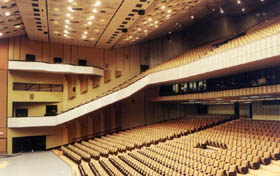
<title>Palace of Culture Celebrates a Quarter Century Since Its Opening</title>The Palace of Culture is celebrating a quarter of a century since its opening.
 |
The government decided in February 1975 to construct a building where the most significant cultural and political events would take place. An architectural competition was announced regarding the design of the building, in which the jury debated between the projects of the Military Project Institute and the Project Institute of the Capital City of Prague. The military designs were favored, drawing inspiration from a similar facility in Hamburg. According to architect Jan Bočan, who participated in the competing proposal, the competition was manipulated. "It was a political decision. The competition went through additional rounds until the jury finally chose the design of the Military Project Institute," Bočan complained to the press in the 1990s.
The project by architects Mayer, Vaněk, and Karlík, in the form of a neo-functionalistic monoblock with an irregular heptagonal layout, began construction in 1976 on the southern foreland of the Nusle Bridge (then Klement Gottwald Bridge). It was completed five years later. It was one of the largest buildings of its kind in Europe, and due to its considerable size, popular creativity nicknamed the building Lidojem. However, a much more widespread name became Pakul.
The ceremonial opening of the building on April 2, 1981, attracted the political elite of communist Czechoslovakia, led by General Secretary of the Central Committee of the Communist Party of Czechoslovakia and President Gustáv Husák, who symbolically cut the ribbon. Four days later, the 16th Congress of the Communist Party took place inside the building.
The congresses of the communist party and various components of the National Front became a regular part of the program. Even at the beginning of December 1989, the palace hosted a nationwide congress of unified agricultural cooperatives, whose participants, however, received leaflets from the Civic Forum (OF) upon entering the building. A few days later, representatives of the communist regime and OF gathered at the same location to negotiate, resulting in the formation of the first post-November government.
However, the palace was not just a place for political meetings; it also hosted concerts of the Prague Spring, showcased a retrospective of Semafor, and featured performances by Laterna Magika. In the 1990s, well-known names from contemporary world music found their way to Pakul, including B.B. King, Joan Baez, and Björk. The building also housed the Pevnost cinema and hosted film festivals.
From 1998 to 2000, the building underwent a major reconstruction costing more than three billion crowns. The main attraction became the reconstructed Congress Hall, which, according to the Congress Centre, ranks among the 13 best concert halls in the world and is acoustically comparable to London's famous Royal Albert Hall. Additionally, the complex expanded to include a multifunctional building housing, among other facilities, offices and a hotel.
Immediately after the completion of the reconstruction in September 2000, the building underwent a stress test in the form of the annual meeting of the International Monetary Fund and the World Bank. Two years later, NATO also chose the building for its meeting.
However, even the current form of the palace does not seem to be final. The management of the center has already initiated a project for the construction of new buildings towards the Nusle Valley. However, the unresolved issue remains financing the construction.
The English translation is powered by AI tool. Switch to Czech to view the original text source.
1 comment
add comment
Subject
Author
Date
akustika Pakul
Ondřej Císler
30.03.06 11:45
show all comments










